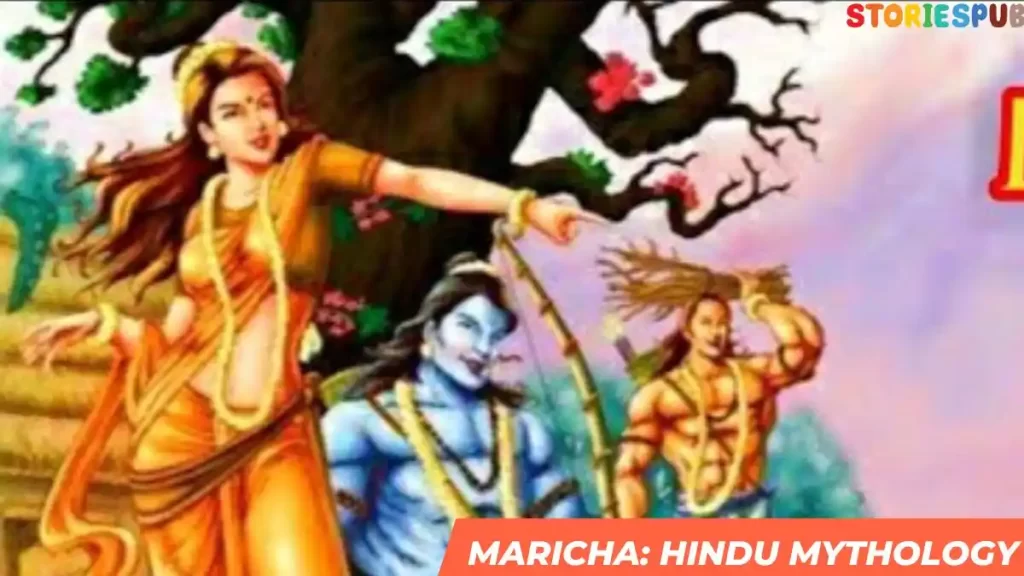Summarize this Article with:
Maricha: The Deceitful Demon of Hindu Mythology

Maricha is one of the many demons featured in Hindu mythology. According to the legend, he was born to the demoness Tataka and was the brother of Subahu. Tataka was a powerful demoness who terrorized the people and was eventually killed by Rama’s brother, Lakshmana.
Despite being a demon, Maricha was not inherently evil. In fact, he was a family-oriented demon who had a close relationship with his mother and brother. However, his allegiance to his family often conflicted with his loyalty to his demon kingdom, which led him to make some questionable decisions.
Maricha’s cunning and deceitful nature made him a powerful demon in Hindu mythology. He lived in the Dandaka Forest, where Rama, Sita, and Lakshmana were living in exile. Maricha had heard of Rama’s reputation as a great warrior and knew that he posed a threat to his demon kingdom.
Maricha decided to help Ravana, the demon king of Lanka, by creating a diversion. He transformed himself into a beautiful golden deer and ran through the forest where Rama and Sita were staying. Sita, who was enchanted by the deer, asked Rama to catch it for her. Rama agreed, and he chased the deer deep into the forest.
As Rama chased the deer, he noticed that the deer was leading him farther and farther away from Sita. Eventually, Rama realized that the deer was a trick and shot it with his arrow. As the deer died, it transformed back into Maricha.
Maricha’s plan to lure Rama away from Sita was successful, and it gave Ravana the opportunity to kidnap Sita. However, his role in the kidnapping ultimately led to his downfall. Rama and his army defeated Ravana and rescued Sita, and Maricha was killed by Rama’s arrow.
The story of Maricha serves as a cautionary tale about the dangers of deceit and the consequences of one’s actions. Maricha’s decision to help Ravana ultimately led to his own demise, and his deceitful actions brought about his downfall.
Maricha’s role in the Ramayana was significant, as he was responsible for luring Rama away from Sita and creating an opportunity for Ravana to kidnap her. Maricha’s deceitful actions highlight the dangers of attachment and desire, as his desire to protect his demon kingdom led him to make a questionable decision that ultimately resulted in the kidnapping of Sita.
Maricha’s deception took the form of a golden deer, which symbolizes how attachment and desire can lead to illusion. Sita was enchanted by the beauty of the deer and desired to possess it, which ultimately led to her kidnapping. Maricha’s actions serve as a reminder of the power of Maya or illusion, which can cloud our judgment and lead us astray.
In Hindu philosophy, Maya is the veil of illusion that separates us from the divine. It is only through the wisdom of the divine that we can see through the veil of Maya and attain true knowledge and enlightenment. Maricha’s deception in the form of the golden deer serves as a cautionary tale about the dangers of attachment and desire, and the importance of cultivating wisdom and detachment in our lives.
The origin of Maricha’s demon status is not mentioned in Hindu mythology. It is believed that he was born as a demon, just like his mother, Tataka.
Maricha’s story in Hindu mythology highlights the concept of Maya or illusion. His cunning nature and deceitful actions serve as a reminder to be wary of our desires and to cultivate wisdom and detachment in our lives. The moral lesson from Maricha’s story in the Ramayana is that attachment and desire can lead to illusion and deceit. It is only through the wisdom of the divine that one can see through the veil of Maya and find true happiness and fulfillment in life.
Maricha’s attempt to help Ravana kidnap Sita was unsuccessful, as Rama ultimately defeated Ravana and rescued his wife. Maricha’s role in the Ramayana is a reminder that evil may use deception and cunning to achieve its goals, but ultimately, it will be defeated by the power of righteousness.
Lord Rama defeated Maricha by shooting him with his arrow. Maricha was killed instantly, and he could not escape Rama’s wrath. Maricha’s defeat serves as a warning against the power of ego and the consequences of using one’s abilities for selfish gain.
In Hindu art and literature, Maricha is often depicted as a golden deer or a demon with animalistic features. His story in the Ramayana has been retold in many different forms, including plays, films, and television shows.
Overall, Maricha’s story in Hindu mythology is a cautionary tale about the dangers of attachment and the power of illusion. It serves as a reminder to stay true to our values and to always act with integrity, even when faced with temptation or deceit. Through wisdom and detachment, we can overcome the veil of Maya and achieve true happiness and fulfillment in life.
Maricha FAQ
1. Who is Maricha in Hindu mythology?
Maricha is a demon in Hindu mythology with the power to transform himself into any animal or object he desires. He is known for his deceitful and cunning nature and is considered one of the most powerful demons of his time.
2. What is Maricha's role in the Ramayana?
Maricha's role in the Ramayana is significant, as he was responsible for luring Rama away from Sita and creating an opportunity for Ravana to kidnap her. Maricha's actions highlight the dangers of attachment and desire and serve as a reminder of the power of illusion or Maya.
3. How did Maricha become a demon in Hindu mythology?
Maricha was born to the demoness Tataka and was the brother of Subahu. His origin story and how he became a demon are not mentioned in Hindu mythology.
4. What are Maricha's powers in Hindu mythology?
Maricha's most prominent power is the ability to transform himself into any animal or object he desires. He is also known for his strength and cunning nature.
5. What is the significance of Maricha in Hindu mythology?
Maricha's story in Hindu mythology highlights the complexity of good and evil and the dangers of attachment and desire. His story serves as a cautionary tale about the power of Maya or illusion and the importance of cultivating wisdom and detachment in our lives.
6. Why did Maricha help Ravana in the Ramayana?
Maricha helped Ravana in the Ramayana because he saw Rama as a threat to his demon kingdom. His loyalty to his kingdom often conflicted with his moral compass, leading him to make questionable decisions.
7. How did Lord Rama defeat Maricha in the Ramayana?
Lord Rama defeated Maricha by shooting him with his arrow. Maricha was killed instantly, and he could not escape Rama's wrath.
8. What is the moral lesson from Maricha's story in the Ramayana?
The moral lesson from Maricha's story in the Ramayana is that attachment and desire can lead to illusion and deceit. It is only through the wisdom of the divine that one can see through the veil of Maya and find true happiness and fulfillment in life.
9. How is Maricha depicted in Hindu art and literature?
Maricha is often depicted in Hindu art and literature as a golden deer or a demon with animalistic features. His story in the Ramayana has been retold in many different forms, including plays, films, and television shows.
10. Is Maricha worshipped in Hinduism?
Maricha is not worshipped in Hinduism, but his story is an important part of Hindu mythology and is often retold in religious and cultural contexts.
Hey kids, how much did you like The The Divine Life Story of Shri Krishna? Please share your view in the comment box. Also, please share this story with your friends on social media so they can also enjoy it, and for more such Hindu Mythology, , please bookmark storiespub.com.
Check out other stories that we have:
- 1. Lord Ganesha
- 2. Bhagavad Gita
- 3. Mahabharat
- 4. Tale of Jalandhar
- 5. Story of Prahlad
- 6. Rani Padmini















